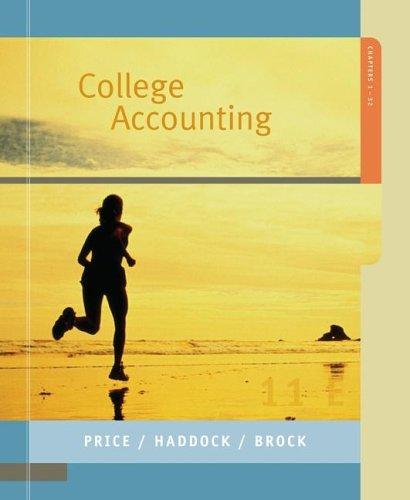See the Take-Two Interactive Software, Inc. case for these questions.
1- Analyze Take-Two's 1998-2000 financial data included in Exhibit 1. Compute the following financial ratios for each of those years: age of accounts receivable, age of inventory, gross profit percentage, profit margin percentage, return on assets, return on equity, current ratio, debt-to-equity ratio, and the quality-of-earnings ratio. What major "red flags," if any, were present in Take-Two's financial statements given these ratios? Explain.
2- Identify the primary audit objectives that auditors hope to accomplish by confirming a client's year-end accounts receivable. Explain the difference between "positive" and "negative" confirmation requests and discuss the quality of audit evidence yielded by each.
3- Identify audit tests that may be used as alternative audit procedures when a response is not received for a positive confirmation request. Compare and contrast the quality of audit evidence yielded by these procedures with that produced by audit confirmation procedures.
4- In your opinion, did the apparent mistakes made by the PwC auditors in auditing Take-Two's receivables and reserve for sales returns involve "negligence" on their part? Would you characterize the mistakes or errors as "reckless" or "fraudulent"? Justify your answers.
5- Is it appropriate for audit firms to sharply discount their professional fees for developmental stage companies? Why or why not? What problems, if any, may this practice pose for audit firms?
6- Do you believe that the relationship between Robert Fish and Ryan Brant was inappropriate? Explain.
7- Should audit firms accept "ethically challenged" companies and organizations as audit clients? Defend your answer.
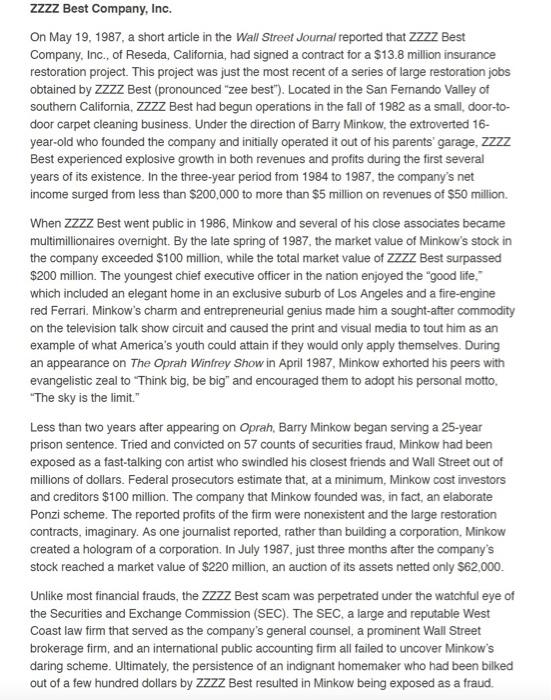

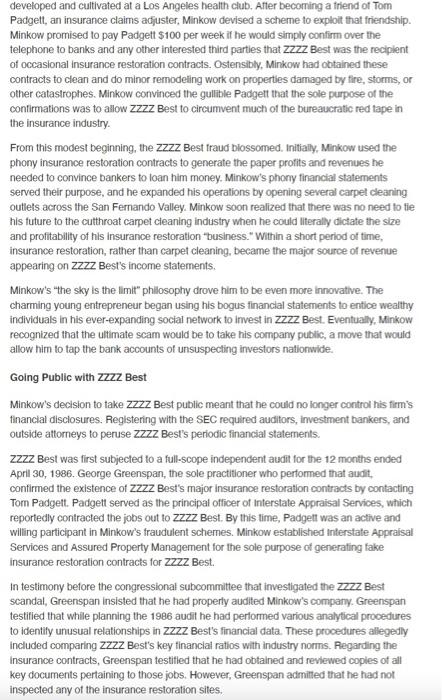

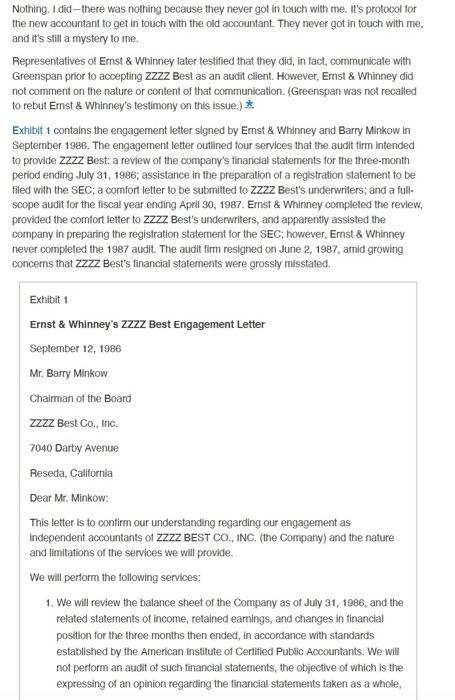
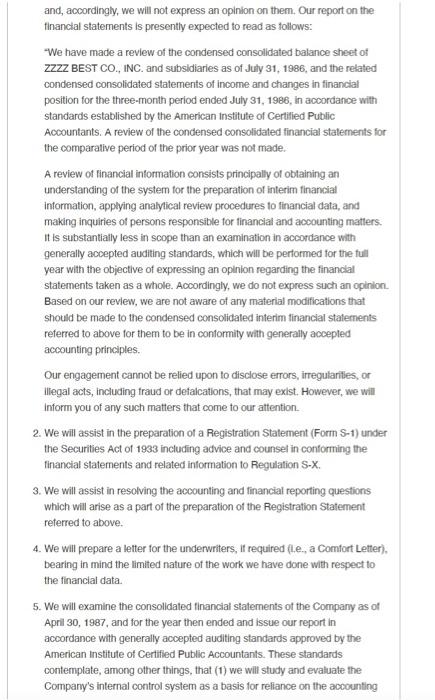
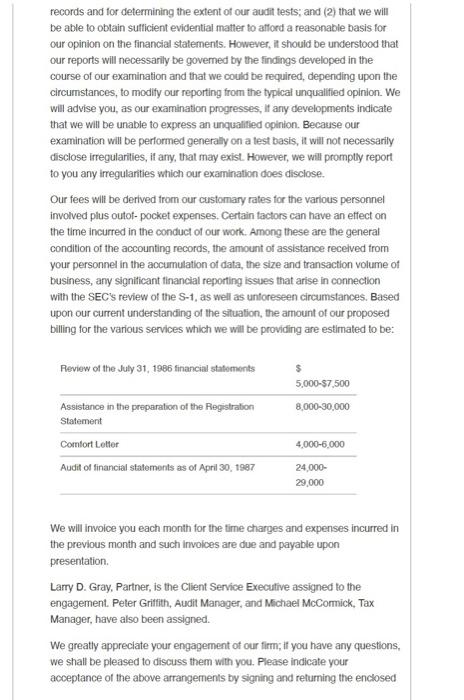


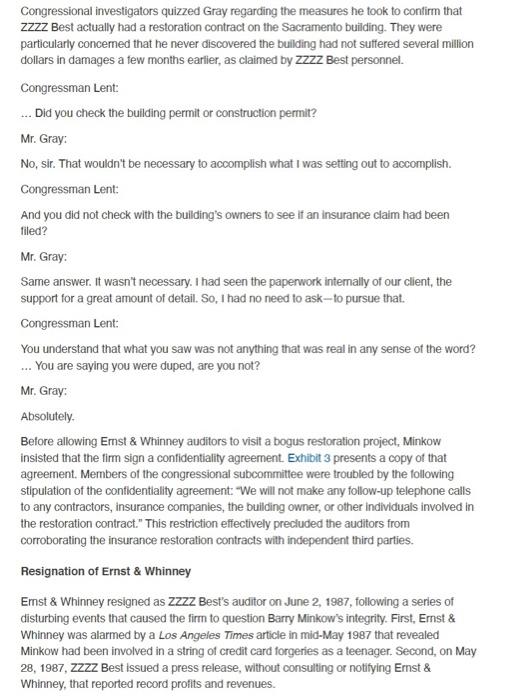
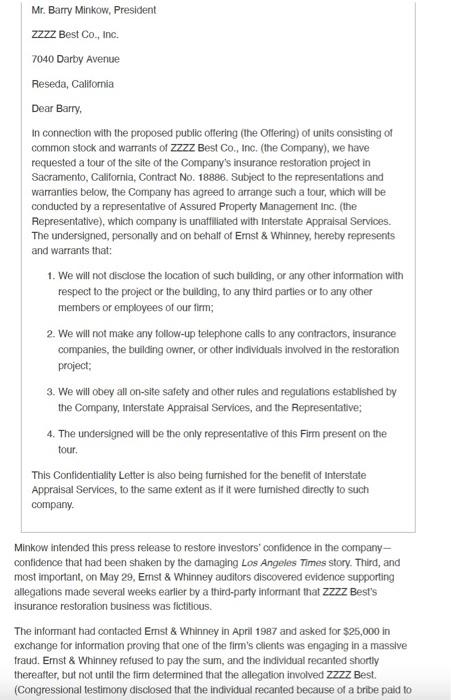
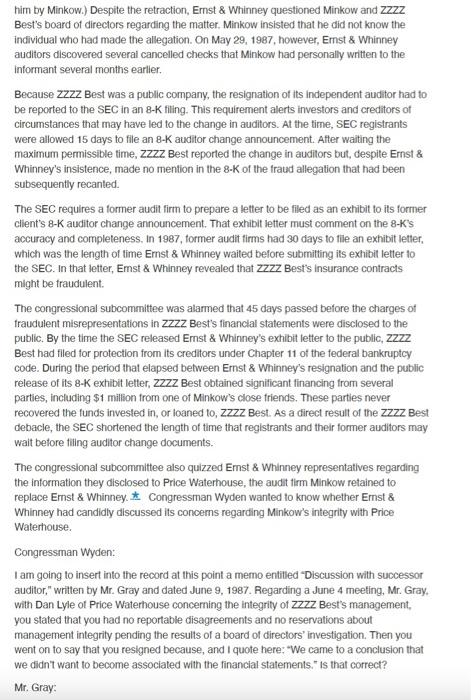
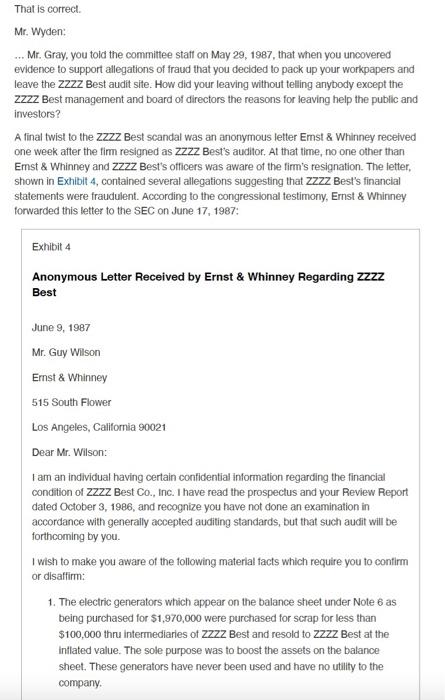


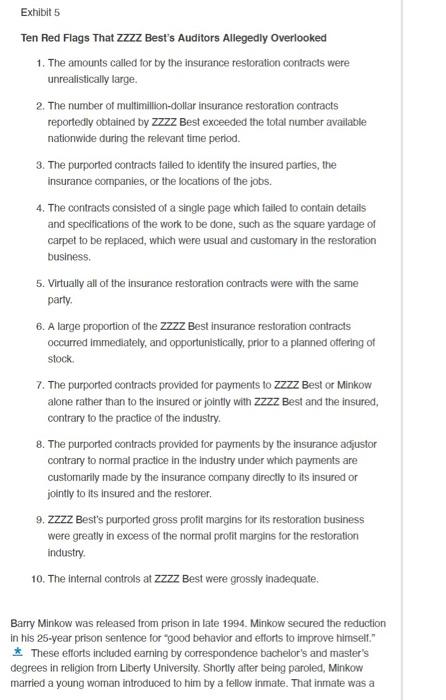
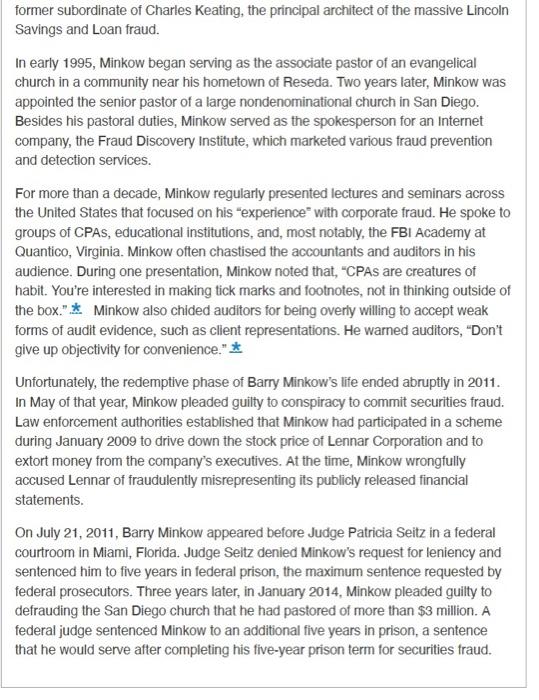
ZZZZ Best Company, Inc. On May 19, 1987, a short article in the Wall Street Journal reported that ZZZZ Best Company, Inc., of Reseda, California, had signed a contract for a $13.8 million insurance restoration project. This project was just the most recent of a series of large restoration jobs obtained by ZZZZ Best (pronounced "zee best"). Located in the San Fernando Valley of southern California, ZZZZ Best had begun operations in the fall of 1982 as a small, door-to- door carpet cleaning business. Under the direction of Barry Minkow, the extroverted 16- year-old who founded the company and initially operated it out of his parents' garage, ZZZZ Best experienced explosive growth in both revenues and profits during the first several years of its existence. In the three-year period from 1984 to 1987, the company's net income surged from less than $200,000 to more than $5 million on revenues of $50 million When ZZZZ Best went public in 1986, Minkow and several of his close associates became multimillionaires overnight. By the late spring of 1987, the market value of Minkow's stock in the company exceeded $100 million, while the total market value of ZZZZ Best surpassed $200 million. The youngest chief executive officer in the nation enjoyed the good life." which included an elegant home in an exclusive suburb of Los Angeles and a fire-engine red Ferrari. Minkow's charm and entrepreneurial genius made him a sought-after commodity on the television talk show circuit and caused the print and visual media to tout him as an example of what America's youth could attain if they would only apply themselves. During an appearance on The Oprah Winfrey Show in April 1987, Minkow exhorted his peers with evangelistic zeal to "Think big, be big" and encouraged them to adopt his personal motto. "The sky is the limit." Less than two years after appearing on Oprah, Barry Minkow began serving a 25-year prison sentence. Tried and convicted on 57 counts of securities fraud, Minkow had been exposed as a fast-talking con artist who swindled his closest friends and Wall Street out of millions of dollars. Federal prosecutors estimate that, at a minimum, Minkow cost investors and creditors $100 million. The company that Minkow founded was, in fact, an elaborate Ponzi scheme. The reported profits of the firm were nonexistent and the large restoration contracts, imaginary. As one journalist reported, rather than building a corporation, Minkow created a hologram of a corporation. In July 1987. just three months after the company's stock reached a market value of $220 million, an auction of its assets netted only $62,000. Unlike most financial frauds, the ZZZZ Best scam was perpetrated under the watchful eye of the Securities and Exchange Commission (SEC). The SEC, a large and reputable West Coast law firm that served as the company's general counsel, a prominent Wall Street brokerage firm, and an international public accounting firm all failed to uncover Minkow's daring scheme. Ultimately, the persistence of an indignant homemaker who had been bilked out of a few hundred dollars by ZZZZ Best resulted in Minkow being exposed as a fraud. How a teenage flimflam artist could make a mockery of the complex regulatory structure that oversees the U.S. securities markets was the central question posed by a congressional subcommittee that investigated the ZZZZ Best debacle. That subcommittee was headed by Representative John D. Dingell, chairman of the U.S. House Committee on Energy and Commerce. Throughout the investigation, Representative Dingell and his colleagues focused on the role the company's Independent auditors played in the ZZZZ Best scandal The ZZZZ Best prospectus told the public that revenues and earnings from insurance restoration contracts were skyrocketing but did not reveal that the contracts were completely fictitious. Where were the independent auditors and the others that are paid to alert the public to fraud and deceit? Like many other daring financial frauds, the ZZZZ Best scandal caused Congress to reexamine the maze of rules that regulate financial reporting and serve as the foundation of the U.S. system of corporate oversight. However, Daniel Akst, a reporter for the Wall Street Journal who documented the rise and fall of Barry Minkow, suggested that another ZZZZ Best was inevitable. "Changing the accounting rules and securities laws will help, but every now and then a Barry Minkow will come along, and ZZZZ Best will happen again. Such trauds are in the natural order of things, I suspect, as old and enduring as human needs." * The Early History of ZZZZ Best Company Barry Minkow was introduced to the carpet cleaning Industry at the age of 12 by his mother, who helped make ends meet by working as a telephone solicitor for a small carpet cleaning firm. Although the great majority of companies in the carpet cleaning industry are legitimate, the nature of the business attracts a disproportionate number of shady characters. There are essentially no barriers to entry, no licensing requirements, no apprenticeships to be served, and only a minimal amount of startup capital is needed. A 16-year-old youth with a driver's license can easily become what industry insiders refer to as a rug sucker," which is exactly what Minkow did when he founded ZZZZ Best Company. Minkow quickly learned that carpet cleaning was a difficult way to earn a livelihood. Customer complaints, ruthless competition, bad checks, and nagging vendors demanding payment complicated the young entrepreneur's life. Within months of striking out on his own, Minkow faced the ultimate nemesis of the small businessperson: a shortage of working capital. Because of his age and the fact that ZZZZ Best was only marginally profitable, local banks refused to loan him money. Ever resourceful, the brassy teenager came up with his own Innovative ways to finance his business: check kiting, credit card forgeries, and the staging of thefts to fleece his insurance company. Minkow's age and personal charm allowed him to escape unscathed from his early brushes with the law that resulted from his creative financing methods. The ease with which the "systern" could be beaten encouraged him to exploit it on a broader scale. Throughout his tenure with ZZZZ Best, Minkow recognized the benefits of having an extensive social network of friends and acquaintances. Many of these relationships he developed and cultivated at a Los Angeles health club. After becoming a friend of Tom Padgett, an insurance claims adjuster, Minkow devised a scheme to exploit that friendship. Minkow promised to pay Padget $100 per week if he would simply confirm over the telephone to banks and any other interested third parties that ZZZZ Best was the recipient of occasional insurance restoration contracts. Ostensibly, Minkow had obtained these contracts to clean and do minor remodeling work on properties damaged by fire, storms, or other catastrophes. Minkow convinced the gullible Padget that the sole purpose of the confirmations was to allow ZZZZ Best to circumvent much of the bureaucratic red tape in the insurance industry. From this modest beginning, the ZZZZ Best fraud blossomed. Initially, Minkow used the phony insurance restoration contracts to generate the paper profits and revenues he needed to convince bankers to loan him money. Minkow's phony financial statements served their purpose, and he expanded his operations by opening several carpet cleaning outlets across the San Fernando Valley. Minkow soon realized that there was no need to fie his future to the cutthroat carpet cleaning industry when he could literally dictate the size and profitability of his insurance restoration business. Within a short period of time, insurance restoration, rather than carpet cleaning, became the major source of revenue appearing on ZZZZ Best's income statements. Minkow's "the sky is the limit" philosophy drove him to be even more innovative. The charming young entrepreneur began using his bogus financial statements to entice wealthy individuals in his ever-expanding social network to invest in ZZZZ Best. Eventually, Minkow recognized that the ultimate scam would be to take his company public, a move that would allow him to tap the bank accounts of unsuspecting investors nationwide. Going Public with ZZZZ Best Minkow's decision to take ZZZZ Best public meant that he could no longer control his firm's financial disclosures. Registering with the SEC required auditors, investment bankers, and outside attorneys to peruse ZZZZ Best's periodic financial statements. ZZZZ Best was first subjected to a full-scope independent audit for the 12 months ended April 30, 1986. George Greenspan, the sole practitioner who performed that audit, confirmed the existence of ZZZZ Best's major Insurance restoration contracts by contacting Tom Padgett. Padgett served as the principal officer of Interstate Appraisal Services, which reportedly contracted the jobs out to ZZZZ Best. By this time, Padgett was an active and willing participant in Minkow's fraudulent schemes. Minkow established Interstate Appraisal Services and Assured Property Management for the sole purpose of generating fake insurance restoration contracts for ZZZZ Best. In testimony before the congressional subcommittee that investigated the ZZZZ Best scandal, Greenspan insisted that he had properly audited Minkow's company. Greenspan testified that while planning the 1986 audit he had performed various analytical procedures to identity unusual relationships in ZZZZ Best's financial data. These procedures allegedly included comparing ZZZZ Best's key financial ratios with industry norms. Regarding the Insurance contracts, Greenspan testified that he had obtained and reviewed copies of all key documents pertaining to those jobs. However, Greenspan admitted that he had not inspected any of the insurance restoration sites. Congressman Lent: Mr. Greenspan, I am interested in the SEC Form S-1 that ZZZZ Best Company filed with the SEC.... You say in that report that you made your examination in accordance with generally accepted auditing standards and accordingly included such tests of the accounting records and other auditing procedures as we consider necessary in the circumstances.... You don't say in that statement that you made any personal on-site inspections Mr. Greenspan: it's not required. Sometimes you do, sometimes you don't. I was satisfied that these jobs existed and I was satisfied from at least six different sources, including payment for the job. What could you want better than that? Congressman Lent: Your position is that you are an honest and reputable accountant. Mr. Greenspan: Yes, sir. Congressman Lent: You were as much a victim as some of the Investors in this company? Mr. Greenspan: I was a victim all right.... I am as much aghast as anyone, And every night I sit down and say, why didn't I detect this damned fraud. Retention of Ernst & Whinney by ZZZZ Best Shortly after Greenspan completed his audit of ZZZZ Best's financial statements for fiscal 1986, which ended April 30, 1986, Minkow dismissed him and retained Emst & Whinney to perform the following year's audit. Apparently, ZZZZ Best's investment banker insisted that Minkow obtain a major accounting firm to enhance the credibility of the company's financial statements. At approximately the same time, and for the same reason, Minikow retained a high-profile Los Angeles law firm to represent ZZZZ Best as its legal counsel The congressional subcommittee asked Greenspan what information he provided to Emst & Whinney regarding his former client. In particular, the subcommittee wanted to know whether Greenspan discussed the insurance restoration contracts with the new auditors. Congressman Wyden: Mr. Greenspan, in September 1986, Ernst & Whinney came on as the new independent accountant for ZZZZ Best. What did you communicate to Emst & Whinney with respect to the restoration contracts ? Mr. Greenspan: Nothing, I did, there was nothing because they never got in touch with me. It's protocol for the new accountant to get in touch with the old accountant. They never got in touch with me, and it's still a mystery to me. Representatives of Emst & Whinney later testified that they did, in fact, communicate with Greenspan prior to accepting ZZZZ Best as an audit client. However, Ernst & Whinney did not comment on the nature or content of that communication (Greenspan was not recalled to rebut Ernst & Whinney's testimony on this issue.) * Exhibit 1 contains the engagement letter signed by Emst & Whinney and Barry Minkow in September 1986. The engagement letter outlined four services that the audit firm intended to provide ZZZZ Best: a review of the company's financial statements for the three-month period ending July 31, 1996; assistance in the preparation of a registration statement to be filed with the SEC; a comfort letter to be submitted to ZZZZ Best's underwriters; and a full- scope audit for the fiscal year ending April 30, 1987. Ernst & Whinney completed the review, provided the comfort letter to ZZZZ Best's underwriters, and apparently assisted the company in preparing the registration statement for the SEC; however, Ernst & Whinney never completed the 1987 audit. The audit firm resigned on June 2, 1987, amid growing concerns that ZZZZ Best's financial statements were grossly misstated. Exhibit 1 Ernst & Whinney's ZZZZ Best Engagement Letter September 12, 1986 Mr. Barry Minkow Chalman of the Board ZZZZ Best Co., Inc. 7040 Darty Avenue Reseda, California Dear Mr. Minkow: This letter is to contirm our understanding regarding our engagement as independent accountants of ZZZZ BEST CO., INC. (the Company) and the nature and limitations of the services we will provide. We will perform the following services: 1. We will review the balance sheet of the Company as of July 31, 1986, and the related statements of income, retained earnings, and changes in financial position for the three months then ended, in accordance with standards established by the American Institute of Certified Public Accountants. We will not perform an audit of such financial statements, the objective of which is the expressing of an opinion regarding the financial statements taken as a whole, and, accordingly, we will not express an opinion on them. Our report on the financial statements is presently expected to read as follows: "We have made a review of the condensed consolidated balance sheet of ZZZZ BEST CO., INC. and subsidiaries as of July 31, 1986, and the related condensed consolidated statements of income and changes in financial position for the three-month period ended July 31, 1986, in accordance with standards established by the American Institute of Certified Public Accountants. A review of the condensed consolidated financial statements for the comparative period of the prior year was not made. A review of financial information consists principally of obtaining an understanding of the system for the preparation of interim financial information, applying analytical review procedures to financial data, and making inquiries of persons responsible for financial and accounting matters. it is substantially less in scope than an examination in accordance with generally accepted auditing standards, which will be performed for the full year with the objective of expressing an opinion regarding the financial statements taken as a whole. Accordingly, we do not express such an opinion Based on our review, we are not aware of any material modifications that should be made to the condensed consolidated interim financial statements referred to above for them to be in conformity with generally accepted accounting principles. Our engagement cannot be relied upon to disclose errors, irregularities, or illegal acts, including fraud or defalcations, that may exist. However, we will Inform you of any such matters that come to our attention 2. We will assist in the preparation of a Registration Statement (Form S-1) under the Securities Act of 1933 including advice and counsel in conforming the financial statements and related information to Regulation S-X. 3. We will assist in resolving the accounting and financial reporting questions which will arise as a part of the preparation of the Registration Statement referred to above. 4. We will prepare a letter for the underwriters, if required (Le., a Comfort Letter). bearing in mind the limited nature of the work we have done with respect to the financial data 5. We will examine the consolidated financial statements of the Company as of April 30, 1987, and for the year then ended and issue our report in accordance with generally accepted auditing standards approved by the American Institute of Certified Public Accountants. These standards contemplate, among other things, that (1) we will study and evaluate the Company's internal control system as a basis for reliance on the accounting records and for determining the extent of our audit tests; and (2) that we will be able to obtain sufficient evidential matter to afford a reasonable basis for our opinion on the financial statements. However, it should be understood that our reports will necessarily be governed by the findings developed in the course of our examination and that we could be required, depending upon the circumstances, to modify our reporting from the typical unqualified opinion. We will advise you, as a s our examination progresses, it any developments indicate that we will be unable to express an unqualified opinion. Because our examination will be performed generally on a test basis, it will not necessarily disclose irregularities, if any, that may exist. However, we will promptly report to you any irregularities which our examination does disclose. Our fees will be derived from our customary rates for the various personnel involved plus outof-pocket expenses. Certain factors can have an effect on the time incurred in the conduct of our work. Among these are the general condition of the accounting records, the amount of assistance received from your personnel in the accumulation of data, the size and transaction volume of business, any significant financial reporting issues that arise in connection with the SEC's review of the S-1, as well as unforeseen circumstances. Based upon our current understanding of the situation, the amount of our proposed billing for the various services which we will be providing are estimated to be: Review of the July 31, 1986 financial statements 5,000-37,500 8,000-30,000 Assistance in the preparation of the Registration Statement Comfort Lotter Audit of financial statements as of April 30, 1987 4.000-6.000 24 000 29,000 We will involce you each month for the time charges and expenses incurred in the previous month and such invoices are due and payable upon presentation. Larry D. Gray, Partner, is the Client Service Executive assigned to the engagement. Peter Griffith, Audit Manager, and Michael McCormick, Tax Manager, have also been assigned. We greatly appreciate your engagement of our firm, if you have any questions, we shall be pleased to discuss them with you. Please indicate your acceptance of the above arrangements by signing and returning the enclosed copy. This letter constitutes the full understanding of the terms of our engagement Very truly yours, Emst & Whinney By Larry D. Gray, Partner ACCEPTED: ZZZZ BEST CO., INC. Barry J. Minkow, Chairman of the Board (signed) 9/16/86 The congressional subcommittee investigating the ZZZZ Best fraud questioned Emst & Whinney representatives at length regarding the bogus insurance restoration contracts- contracts that accounted for 90 percent of ZZZZ Best's reported profits. Congressional testimony disclosed that Emst & Whinney repeatedly insisted on visiting several of the largest of these contract sites and that Minkow and his associates attempted to discourage such visits. Eventually, Minkow realized that the auditors would not relent and agreed to allow them to visit certain of the restoration sites, knowing full well that none of the sites actually existed To convince Emst & Whinney that the insurance restoration contracts were authentic, Minkow plotted and carried out a series of sting operations that collectively cost millions of dollars. In the late fall of 1986, Larry Gray, the engagement audit partner for ZZZZ Best, told client personnel that he wanted to inspect a restoration site in Sacramento on which ZZZZ Best had reported obtaining a multimillion-dollar contract. Minkow sent two of his subordinates to Sacramento to find a large building under construction or renovation that would provide a plausible site for a restoration contract. Gray had visited Sacramento a tew weeks earlier to search for the site that Minkow had refused to divulge. As chance would have it, the building chosen by the ZZZZ Best conspirators was the same one Gray had identified as the most likely site of the insurance restoration job. Minkow's two confederates posed as leasing agents of a property management firm and convinced the supervisor of the construction site to provide the keys to the building one weekend on the pretext that a large, prospective tenant wished to tour the facility. Prior to the arrival of Larry Gray and an attomey representing ZZZZ Best's law firm, Minkow's subordinates visited the site and placed placards on the walls at conspicuous locations indicating that ZZZZ Best was the contractor for the building renovation. No details were overlooked by the two co-conspirators. They even paid the building's security officer to greet the visitors and demonstrate that he was aware in advance of their tour of the site and its purpose. Although the building had not been damaged and instead was simply in the process of being completed, the sting operation went off as planned. Exhibit 2 presents the Exhibit 2 Ernst & Whinney Internal Memo Regarding Visit to ZZZZ Best Restoration Project TO: ZZZZ Best Co., Inc. File FROM: Larry D. Gray RE: Visit to Sacramento Job At our request, the Company arranged for a tour of the job site in Sacramento on November 23rd (1986). The site (not previously identified for us because of the confidentiality agreement with their customer) had been informally visited by me on October 27. I knew approximately where the job was, and was able to identify it through the construction activity going on. On November 23, Mark Morse accompanied Mark Moskowitz of Hughes Hubbard & Reed and myself to Sacramento. We visited first the offices of the Building Manager, Mark Roddy of Assured Property Management, Inc. Roddy was hired by the insurance company (at Tom Padgett's suggestion according to Morse) to oversee the renovation activities and the leasing of the space. Roddy accompanied us to the building site. We were informed that the damage occurred from the water storage on the roof of the building. The storage was for the sprinkler systems, but the water was somehow released in total, causing construction damage to floors 17 and 18, primarily in bathrooms which were directly under the water holding tower, then the water spread out and flooded floors 16 down through about 5 or 6, where it started to spread out even further and be held in pools. We toured floor 17 briefly it is currently occupied by a law firm) then visited floor 12 (which had a considerable amount of unoccupied space) and floor 7. Morse pointed out to us the carpet, painting and clean-up work which had been ZZZZ Best's responsibility. We noted some work not done in some other areas (and in unoccupied tenant space). But per Mark, this was not ZZZZ Best's responsibility, rather was work being undertaken by tenants for their own purposes. Per Morse (and Roddy) ZZZZ Best's work is substantially complete and has passed final inspection. Final sign-off is expected shortly, with final payment due to ZZZZ Best in early December Morse was well versed in the building history and in the work scope for ZZZZ Best. The tour was beneficial in gaining insight as to the scope of the damage that had occurred and the type of work that the Company can do. Congressional investigators quizzed Gray regarding the measures he took to confirm that ZZZZ Best actually had a restoration contract on the Sacramento building. They were particularly concemed that he never discovered the building had not suffered several million dollars in damages a few months earlier, as claimed by ZZZZ Best personnel. Congressman Lent: ... Did you check the building permit or construction permit? Mr. Gray: No, sir. That wouldn't be necessary to accomplish what I was setting out to accomplish. Congressman Lent: And you did not check with the building's owners to see if an insurance claim had been filed? Mr. Gray: Same answer. It wasn't necessary. I had seen the paperwork internally of our client, the support for a great amount of detail. So, I had no need to ask-to pursue that. Congressman Lent: You understand that what you saw was not anything that was real in any sense of the word? ... You are saying you were duped, are you not? Mr. Gray: Absolutely Before allowing Emst & Whinney auditors to visit a bogus restoration project, Minkow insisted that the firm sign a confidentiality agreement. Exhibit 3 presents a copy of that agreement. Members of the congressional subcommittee were troubled by the following stipulation of the confidentiality agreement: "We will not make any follow-up telephone calls to any contractors, insurance companies, the building owner, or other individuals involved in the restoration contract." This restriction effectively precluded the auditors from corroborating the insurance restoration contracts with independent third parties. Resignation of Ernst & Whinney Emst & Whinney resigned as ZZZZ Best's auditor on June 2, 1987, following a series of disturbing events that caused the firm to question Barry Minkow's integrity. First, Emst & Whinney was alarmed by a Los Angeles Times article in mid-May 1987 that revealed Minkow had been involved in a string of credit card forgeries as a teenager. Second, on May 28, 1987, ZZZZ Best issued a press release, without consulting or notifying Emst & whinney, that reported record profits and revenues. Mr. Barry Minkow, President ZZZZ Best Co., Inc. 7040 Darby Avenue Reseda, California Dear Barry, in connection with the proposed public offering (the Offering) of units consisting of common stock and warrants of ZZZZ Best Co., Inc. (the Company), we have requested a tour of the site of the Company's insurance restoration project in Sacramento, California, Contract No. 18886. Subject to the representations and warranties below, the Company has agreed to arrange such a tour, which will be conducted by a representative of Assured Property Management Inc. (the Representative), which company is unaffiliated with Interstate Appraisal Services. The undersigned, personally and on behalf of Emst & Whinney, hereby represents and warrants that: 1. We will not disclose the location of such building, or any other information with respect to the project or the building, to any third parties or to any other members or employees of our firm; 2. We will not make any follow-up telephone calls to any contractors, insurance companies, the building owner, or other individuals involved in the restoration project: 3. We wili obey all on-site safety and other rules and regulations established by the Company, Interstate Appraisal Services, and the Representative; 4. The undersigned will be the only representative of this Firm present on the tour. This Confidentiality Letter is also being furnished for the benefit of Interstate Appraisal Services, to the same extent as it it were furnished directly to such company. Minkow intended this press release to restore investors' confidence in the company - confidence that had been shaken by the damaging Los Angeles Times story. Third, and most important, on May 29, Ernst & Whinney auditors discovered evidence supporting allegations made several weeks earlier by a third-party informant that ZZZZ Best's Insurance restoration business was fictitious. The informant had contacted Emst & Whinney in April 1987 and asked for $25,000 in exchange for information proving that one of the firm's clients was engaging in a massive fraud. Ernst & Whinney refused to pay the sum, and the individual recanted shortly thereafter, but not until the firm determined that the allegation involved ZZZZ Best. (Congressional testimony disclosed that the individual recanted because of a bribe paid to him by Minkow.) Despite the retraction, Emst & Whinney questioned Minkow and ZZZZ Best's board of directors regarding the matter. Minkow insisted that he did not know the individual who had made the allegation. On May 29, 1987, however, Emst & Whinney auditors discovered several cancelled checks that Minkow had personally written to the informant several months earlier. Because ZZZZ Best was a public company, the resignation of its independent auditor had to be reported to the SEC in an 8-K filing. This requirement alerts investors and creditors of circumstances that may have led to the change in auditors. At the time, SEC registrants were allowed 15 days to file an 8-K auditor change announcement. After waiting the maximum permissible time, ZZZZ Best reported the change in auditors but, despite Ernst & Whinney's insistence, made no mention in the 8-K of the fraud allegation that had been subsequently recanted. The SEC requires a former audit firm to prepare a letter to be filed as an exhibit to its former client's 8-K auditor change announcement. That exhibit letter must comment on the 8-K's accuracy and completeness. In 1987, former audit firms had 30 days to file an exhibit letter. which was the length of time Emst & Whinney waited before submitting its exhibit letter to the SEC. In that letter, Emst & Whinney revealed that ZZZZ Best's insurance contracts might be fraudulent The congressional subcommittee was alarmed that 45 days passed before the charges of fraudulent misrepresentations in ZZZZ Best's financial statements were disclosed to the public. By the time the SEC released Ernst & Whinney's exhibit letter to the public, ZZZZ Best had filed for protection from its creditors under Chapter 11 of the federal bankruptcy code. During the period that elapsed between Ernst & Whinney's resignation and the public release of its 8-K exhibit letter, ZZZZ Best obtained significant financing from several parties, including $1 million from one of Minkow's close friends. These parties never recovered the funds invested in, or loaned to, ZZZZ Best. As a direct result of the ZZZZ Best debacle, the SEC shortened the length of time that registrants and their former auditors may wait before filing auditor change documents. The congressional subcommittee also quizzed Ernst & Whinney representatives regarding the information they disclosed to Price Waterhouse, the audit firm Minkow retained to replace Emst & Whinney. * Congressman Wyden wanted to know whether Ernst & Whinney had candidly discussed its concerns regarding Minkow's integrity with Price Waterhouse. Congressman Wyden: I am going to insert into the record at this point a memo entitled Discussion with successor auditor," written by Mr. Gray and dated June 9, 1987. Regarding a June 4 meeting, Mr. Gray. with Dan Lyle of Price Waterhouse concerning the integrity of ZZZZ Best's management, you stated that you had no reportable disagreements and no reservations about management integrity pending the results of a board of directors' investigation. Then you went on to say that you resigned because, and I quote here: "We came to a conclusion that we didn't want to become associated with the financial statements." is that correct? Mr. Gray: That is correct Mr. Wyden: ... Mr. Gray, you told the committee staff on May 29, 1987, that when you uncovered evidence to support allegations of fraud that you decided to pack up your workpapers and leave the ZZZZ Best audit site. How did your leaving without telling anybody except the ZZZZ Best management and board of directors the reasons for leaving help the public and investors? A final twist to the ZZZZ Best scandal was an anonymous letter Emst & Whinney received one week after the fim resigned as ZZZZ Best's auditor. At that time, no one other than Emst & Whinney and ZZZZ Best's officers was aware of the firm's resignation. The letter, shown in Exhibit 4, contained several allegations suggesting that ZZZZ Best's financial statements were fraudulent. According to the congressional testimony, Ernst & Whinney forwarded this letter to the SEC on June 17, 1987: Exhibit 4 Anonymous Letter Received by Ernst & Whinney Regarding ZZZZ Best June 9, 1987 Mr. Guy Wilson Ernst & Whinney 515 South Flower Los Angeles, California 90021 Dear Mr. Wilson: I am an individual having certain confidential information regarding the financial condition of ZZZZ Best Co., Inc. I have read the prospectus and your Review Report dated October 3, 1986, and recognize you have not done an examination in accordance with generally accepted auditing standards, but that such audit will be forthcoming by you. I wish to make you aware of the following material facts which require you to confirm or disaffirm: 1. The electric generators which appear on the balance sheet under Note 6 as being purchased for $1,970,000 were purchased for scrap for less than $100,000 thru intermediaries of ZZZZ Best and resold to ZZZZ Best at the Inflated value. The sole purpose was to boost the assets on the balance sheet. These generators have never been used and have no utility to the company 2 Note 5 of the balance sheet discusses joint ventures and two restoration contracts. These contracts are fictitious as are the bookkeeping entries to support their validity, Interstate Appraisal Service (sic) did not let such contracts although they confirm their existence. The same is true for the alleged $7,000,000 Sacramento contract and the $40100 million contracts with Interstate. 3. Further, checks made and passed between ZZZZ Best, its joint venturers and some of its vendors are no more than transactions among conspirators to support the validity of these restoration contracts. 4. Earnings reported by ZZZZ Best are being reported as Billings in excess of costs and estimated earnings on restoration contracts. These contracts do not exist nor do the earnings. This can be confirmed directly by contacting the alleged insurance carriers as well as physical Inspections as to the existence and extent of the contracts. 5. Billings and Earnings for 1985 and 1986 were fabricated by the company before being presented to other accountants for certification Confirmation of these allegations can be accomplished by a careful due diligence. Such due diligence on your behalf is imperative for your protection Very truly yours, B. Cautious (Signed) Collapse of ZZZZ Best The Los Angeles Times article published in mid-May 1987 that disparaged Barry Minkow ultimately doomed the young entrepreneur and his company. Several years earlier, a homemaker had fallen victim to Minkow's credit card forgeries. Minikow had added a fraudulent charge to a credit charge slip the woman had used to make a payment on her account. Despite her persistence, Minkow avoided repaying the small amount. The woman never forgot the insult and tracked down, and kept a record of, individuals who had been similarly harmed by Minkow. At the urging of this woman, a reporter for the Los Angeles Times investigated her allegations. The woman's diary eventually became the basis for the Los Angeles Times article that, for the first time, cast doubt on the integrity of the boy wonder who was the talk of Wall Street. The newspaper article triggered a chain of events that caused ZZZZ Best to collapse and disappear less than three months later. First, a small brokerage firm specializing in newly registered companies with suspicious earnings histories began short-seling ZZZZ Best stock, forcing the stock's price into a tailspin. Second, Emst & Whinney, ZZZZ Best's law tirm, and ZZZZ Best's investment banker began giving more credence to the allegations and rumors of financial wrongdoing by Minkow and his associates. Third, and most important, the article panicked Minkow and compelled him to make several daring moves that cost him even more credibility. The most critical mistake was his issuance of the May 28, 1987 press release that boldly reported record profits and revenues for his firm. Epilogue Among the parties most villtied for their role in the ZZZZ Best scandal was Emst & Whinney. The transcripts of the congressional testimony focusing on the ZZZZ Best fraud included a list of 10 red flags that the audit firm had allegedly overlooked while examining ZZZZ Best's financial statements (see Exhibit 5). Emst & Whinney officials flatly rejected assertions that their firm was even partially to blame for the ZZZZ Best fiasco. In his congressional testimony, Leroy Gardner, the West Coast director of accounting and auditing for Emst & Whinney, maintained that when all the facts were revealed, his firm would be totally vindicated: The ZZZZ Best situation proves at least one thing: a well-orchestrated fraud will often succeed even against careful, honest, hardworking people. The facts that have begun to emerge establish that Minkow along with confederates both inside and outside ZZZZ Best went to extraordinary lengths to deceive Ernst & Whinney. For example, Thomas Padigett, an alleged conspirator, revealed in a recent televised interview that Minkow spent $4 million to deceive Erst & Whinney during a visit to one of ZZZZ Best's job sites. Emst & Whinney never misled investors about the reliability of ZzZz Best's financial statements. Ernst & Whinney never even issued an audit opinion for ZZZZ Best... We are not part of the problem in this case. We were part of the solution. In one of the largest civil suits stemming from the ZZZZ Best fraud, a court ruled that Ernst & Whinney was not liable to a large California bank that had extended ZZZZ Best a multimillion-dollar loan in 1986. The barik alleged that in granting the loan, it had relled upon the review report issued by Emst & Whinney on ZZZZ Best's financial statements for the threemonth period ending July 31, 1988. However, an appellate judge ruled that the bank was not justified in relying on the review report since Emst & Whinney had expressly stated in the report that it was not issuing an opinion on the ZZZZ Best financial statements. "Emst, because it issued only a review report, specifically declined to express an opinion on ZZZZ Best's financial statements. The report expressly disclaimed any right to rely on its content.** In the late 1980s, ZZZZ Best's former stockholders filed a class-action lawsuit against Emst & Whinney, ZZZZ Best's former law firm, and ZZZZ Best's former Investment banker. An Internet publication reported in March 1996 that this lawsuit had been settled privately. The defendants reportedly paid the former ZZZZ Best stockholders $35 million. However, the contribution of each defendant to the settlement pool was not disclosed, Exhibit 5 Ten Red Flags That ZZZZ Best's Auditors Allegedly Overlooked 1. The amounts called for by the insurance restoration contracts were unrealistically large. 2. The number of multimillion-dollar insurance restoration contracts reportedly obtained by ZZZZ Best exceeded the total number available nationwide during the relevant time period. 3. The purported contracts failed to identify the insured parties, the insurance companies, or the locations of the jobs. 4. The contracts consisted of a single page which failed to contain details and specifications of the work to be done, such as the square yardage of carpet to be replaced, which were usual and customary in the restoration business. 5. Virtually all of the insurance restoration contracts were with the same party 6. A large proportion of the ZZZZ Best insurance restoration contracts occurred immediately, and opportunistically, prior to a planned offering of stock 7. The purported contracts provided for payments to ZZZZ Best of Minkow alone rather than to the insured or jointly with ZZZZ Best and the insured, contrary to the practice of the industry. 8. The purported contracts provided for payments by the insurance adjustor contrary to normal practice in the industry under which payments are customarily made by the insurance company directly to its insured or jointly to its insured and the restorer. 9. ZZZZ Best's purported gross profit margins for its restoration business were greatly in excess of the normal profit margins for the restoration industry. 10. The internal controls at zzzz Best were grossly inadequate. Barry Minkow was released from prison in late 1994. Minkow secured the reduction in his 25-year prison sentence for good behavior and efforts to improve himself." * These efforts included earning by correspondence bachelor's and master's degrees in religion from Liberty University. Shortly after being paroled, Minkow married a young woman introduced to him by a fellow inmate. That inmate was a former subordinate of Charles Keating, the principal architect of the massive Lincoln Savings and Loan fraud. In early 1995, Minkow began serving as the associate pastor of an evangelical church in a community near his hometown of Reseda. Two years later, Minkow was appointed the senior pastor of a large nondenominational church in San Diego. Besides his pastoral duties, Minkow served as the spokesperson for an Internet company, the Fraud Discovery Institute, which marketed various fraud prevention and detection services. For more than a decade, Minkow regularly presented lectures and seminars across the United States that focused on his "experience with corporate fraud. He spoke to groups of CPAS, educational institutions, and, most notably, the FBI Academy at Quantico, Virginia. Minkow often chastised the accountants and auditors in his audience. During one presentation, Minkow noted that, "CPAs are creatures of habit. You're interested in making tick marks and footnotes, not in thinking outside of the box."* Minkow also chided auditors for being overly willing to accept weak forms of audit evidence, such as client representations. He warned auditors, "Don't give up objectivity for convenience." * Unfortunately, the redemptive phase of Barry Minkow's life ended abruptly in 2011. In May of that year, Minkow pleaded guilty to conspiracy to commit securities fraud. Law enforcement authorities established that Minkow had participated in a scheme during January 2009 to drive down the stock price of Lennar Corporation and to extort money from the company's executives. At the time, Minkow wrongfully accused Lennar of fraudulently misrepresenting its publicly released financial statements. On July 21, 2011, Barry Minkow appeared before Judge Patricia Seitz in a federal courtroom in Miami, Florida. Judge Seitz denied Minkow's request for leniency and sentenced him to five years in federal prison, the maximum sentence requested by federal prosecutors. Three years later, in January 2014, Minkow pleaded guilty to defrauding the San Diego church that he had pastored of more than $3 million. A federal judge sentenced Minkow to an additional five years in prison, a sentence that he would serve after completing his five-year prison term for securities fraud























